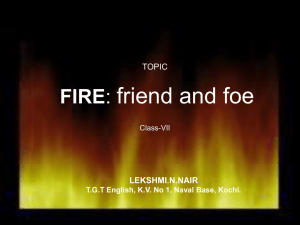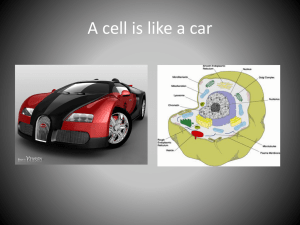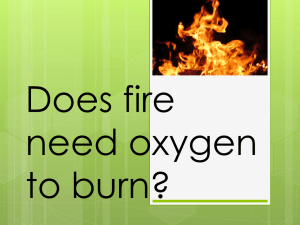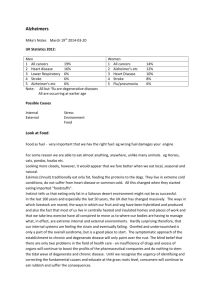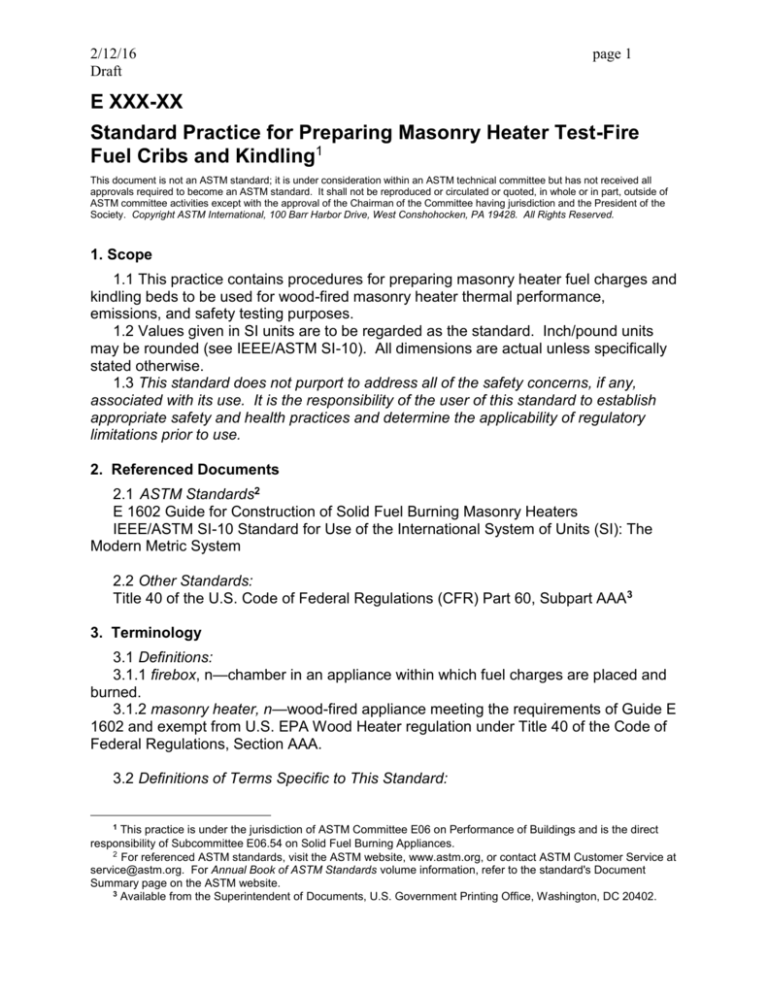
2/12/16
Draft
page 1
E XXX-XX
Standard Practice for Preparing Masonry Heater Test-Fire
Fuel Cribs and Kindling1
This document is not an ASTM standard; it is under consideration within an ASTM technical committee but has not received all
approvals required to become an ASTM standard. It shall not be reproduced or circulated or quoted, in whole or in part, outside of
ASTM committee activities except with the approval of the Chairman of the Committee having jurisdiction and the President of the
Society. Copyright ASTM International, 100 Barr Harbor Drive, West Conshohocken, PA 19428. All Rights Reserved.
1. Scope
1.1 This practice contains procedures for preparing masonry heater fuel charges and
kindling beds to be used for wood-fired masonry heater thermal performance,
emissions, and safety testing purposes.
1.2 Values given in SI units are to be regarded as the standard. Inch/pound units
may be rounded (see IEEE/ASTM SI-10). All dimensions are actual unless specifically
stated otherwise.
1.3 This standard does not purport to address all of the safety concerns, if any,
associated with its use. It is the responsibility of the user of this standard to establish
appropriate safety and health practices and determine the applicability of regulatory
limitations prior to use.
2. Referenced Documents
2.1 ASTM Standards2
E 1602 Guide for Construction of Solid Fuel Burning Masonry Heaters
IEEE/ASTM SI-10 Standard for Use of the International System of Units (SI): The
Modern Metric System
2.2 Other Standards:
Title 40 of the U.S. Code of Federal Regulations (CFR) Part 60, Subpart AAA3
3. Terminology
3.1 Definitions:
3.1.1 firebox, n—chamber in an appliance within which fuel charges are placed and
burned.
3.1.2 masonry heater, n—wood-fired appliance meeting the requirements of Guide E
1602 and exempt from U.S. EPA Wood Heater regulation under Title 40 of the Code of
Federal Regulations, Section AAA.
3.2 Definitions of Terms Specific to This Standard:
1 This practice is under the jurisdiction of ASTM Committee E06 on Performance of Buildings and is the direct
responsibility of Subcommittee E06.54 on Solid Fuel Burning Appliances.
2 For referenced ASTM standards, visit the ASTM website, www.astm.org, or contact ASTM Customer Service at
service@astm.org. For Annual Book of ASTM Standards volume information, refer to the standard's Document
Summary page on the ASTM website.
3 Available from the Superintendent of Documents, U.S. Government Printing Office, Washington, DC 20402.
2/12/16
Draft
page 2
3.2.1 firebox height (ht), n—vertical dimension measured from the firebox floor or
from the top surface of an elevated grate to the horizontal plane that intersects and is
perpendicular to the top edge at the highest point of the firebox opening through which
fuel is loaded.
3.2.1.1 Discussion--If fuel is not intended to be placed at this prescribed firebox
height, an alternative firebox height may be specified by the manufacturer or builder.
Any alternative firebox height assigned by the manufacturer or builder shall be clearly
and permanently indicated by markings and labeling in clear operator view while placing
fuel in the firebox.
3.2.2 firebox volume, n--mathematical product of the firebox height and the usable
hearth area.
3.2.3 primary horizontal hearth dimension (PHhd), n—for all hearth shapes, the
primary horizontal hearth dimension is the longest horizontal straight line that can be
drawn on the hearth within the space intended for fuel placement (see Appendix XI for
examples).
3.2.3.1 If a fuel-elevating grate is used, the primary horizontal hearth dimension,
PHhd, is the longest horizontal straight line that can be drawn across the upper-most
horizontal plane of the grate at the level where fuel and kindling are placed for burning.
3.2.4 secondary horizontal hearth dimension (SHhd), n—for all hearth area shapes,
and for fireboxes with or without fuel-elevating grates, the secondary horizontal hearth
dimension is the longest horizontal straight line that can be drawn within the hearth area
perpendicular to the primary horizontal hearth dimension (PHhd).
NOTE 1--For square and full-circle hearths, the secondary and longest horizontal
firebox dimensions are equal.
3.2.5 usable hearth area (Ahearth), n--largest projected horizontal plane of the firebox.
3.2.5.1 Discussion--The usable hearth area shall be calculated as the sum of all
geometric areas in the largest projected horizontal plane within the firebox unless a
smaller usable hearth area is physically defined (see Appendix XI for examples). For
fireboxes with elevated grates, the usable hearth area shall be calculated as the largest
projected horizontal area of the grate.
4. Significance and Use
4.1 This practice provides a reproducible, repeatable procedure for preparing fuel
cribs for test firing masonry heaters. Fuel cribs and kindling prepared according to this
practice can be used in other masonry heater test methods for thermal performance,
safety, and emissions.
5. Equipment and Instrumentation
5.1 Scale, capable of measuring mass weight in increments of 0.05 kg (0.1 lb) and
having a load capacity of 200 kg (440 lb).
5.2 Wood Moisture Meter, capable of measuring wood moisture in increments of 0.1
% dry basis and having a range from 5 % up to at least 30 % dry basis.
5.3 Linear-Measure Equipment, a standard-verified meter stick or tape measure
capable of measuring increments of 2 mm (0.1 in.).
2/12/16
Draft
page 3
5.4 Oxygen Analyzer, capable of measuring flue gas oxygen concentration within 0.1
%.
5.5 Saw, equipped with all of the appropriate Occupational Safety and Health
Administration (OSHA) safeguards for safely sawing long (1- to 5-m (3 to 16-ft)) pieces
of 89- by 89-mm (3.5- by 3.5-in.) hard and soft wood lumber.
6. Procedure for Fuel Crib Preparation
6.1 Test Fuel—Test fuel shall be air dried Douglas fir or spruce. The wood species
of all fuel pieces burned for a test shall be the same and shall be reported with the test
results.
Test fuel pieces shall consist of 89- by 89-mm (3.5- by 3.5-in.) and 89- by 51-mm (3.5by 2-in.) actual dimensioned lumber. The average moisture content of each piece of
fuel, as measured at three locations on each piece (one each not closer than 7.6 mm
(3.0 in.) from each end and one near the middle of the length), at a depth of 25 mm (1
in.), shall be in the range of 19 to 25 % dry basis (16 to 20 % wet basis).
NOTE 2--Most wood moisture meters measure in dry-basis percent. Verify the
moisture meter specifications to confirm its moisture basis output measurement type.
6.2 Test Fuel Length
6.2.1 Fireboxes Without Elevated Grates--The required length of all fuel pieces
shall be determined using Eq 1 as follows:
Lfp = {0.707 - [0.203 × (SHhd/PHhd)]} × PHhd
(1)
Where:
Lfp = fuel piece length, m (ft);
SHhd = the secondary horizontal hearth dimension, m (ft); and
PHhd = the primary horizontal hearth dimension, m (ft).
6.2.2 Fireboxes with Elevated Grates--If a fuel-elevating grate is used in the firebox,
a fuel piece length shall be the shorter of 1.5 times the primary fuel-elevating grate
dimension or Lfp.
6.3 Fuel Crib Volume, Vf—The fuel crib volume, Vf, is the total amount of fuel
contained in each fuel crib, excluding the kindling. This practice contains the procedure
for preparing three fuel cribs.
6.3 .1 The fuel crib volume, Vf, shall be calculated using a loading factor of 0.20 m3
of wood fuel per m3 of firebox volume (0.20 ft3 per ft3) for the first 33.3 % of the firebox
height and using a loading factor of 0.10 m3 of wood fuel per m3 (0.10 ft3 per ft3) of
firebox volume above 33.3 % of the firebox height (see Appendix XI for example
calculations).
Vf = (0.20 m3/m3)(0.333)(ht)(Ahearth) + (0.10 m3/m3)(0.667)(ht)(Ahearth)
Vf = (0.20 ft3/ft3)(0.333)(ht)(Ahearth) + (0.10 ft3/ft3)(0.667)(ht)(Ahearth)
(2–SI)
(2–inch- pound)
2/12/16
Draft
page 4
6.3.2 Elevated Grates--For fireboxes with elevated grates, the fuel crib volume, Vf,
calculated by Eq 2 shall be multiplied by a factor of 1.5 but shall not exceed the fuel crib
volume calculated using the usable hearth area without the grate.
6.4 Test Fuel Cribs—The test fuel pieces specified in 6.1-6.3 shall be constructed
into fuel load “cribs” having multiple layers as needed to provide the fuel crib volume. A
test fuel crib shall consist of at least two layers of fuel pieces. Three separate fuel load
cribs shall be prepared as described in 6.4-6.6.
6.4.1 The overall horizontal fuel crib width (Hcw) shall be determined using Eq 3 as
follows:
Hcw = {0.707 - [0.203 × (SHhd/PHhd)]} × SHhd
(3)
Where:
Hcw = horizontal crib width, m (ft);
SHhd = the secondary horizontal hearth dimension, m (ft); and
PHhd = the primary horizontal hearth dimension, m (ft).
6.4.1.1 First fuel load crib--Except as specified in 6.4.2, the bottom (first) layer of the
first fuel load crib shall consist entirely of 89- by 51-mm (3.5- by 2.0-in.) fuel pieces
nailed parallel to each other with 19-mm (0.75-in.) spacing between them and with their
89-mm (3.5-in.) sides positioned vertically. The second, third, and higher layers of the
first fuel load crib shall consist entirely of 89- by 89-mm (3.5- by 3.5-in.) fuel pieces
nailed together with spacers as specified in 6.6. See FIG 1.
6.4.1.2 Second and third fuel load cribs--Except as specified in 6.4.2, the second
and third fuel load cribs shall consist entirely of 89- by 89-mm (3.5- by 3.5-in.) fuel
pieces nailed parallel to each other with 19-mm (0.75-in.) spacing between them as
shown in FIG 2. See 6.6 for wood spacer specifications and construction.
6.4.2 For fireboxes having a height of less than 305 mm (12 in.), the height of each
fuel piece and all vertically positioned fuel crib spacers shall be reduced proportionally
to the amount that the firebox height is less than 305 mm (12 in.).
6.4.2.1 For example, if a firebox has a height of 203 mm (8 in.), each piece of the
fuel load and all vertical fuel piece spacers shall be reduced in height to [(203/305 mm)
× 89 mm = 59.2 mm] [(8/12 in.) × 3.5 in. = 2.3 in.]. The unit volumes for all reduced fuel
piece sizes shall be used in all subsequent calculations for determining the number of
fuel pieces contained in each fuel load crib.
6.5 Determination of Fuel Crib Configuration
6.5.1 First Fuel Crib – The first fuel crib shall be made of a bottom/first layer
containing the number of pieces calculated in Eq 4, plus one or more additional layers.
The aggregate number of pieces used in the second and higher layers (Ntop) shall be
determined in accordance with 6.5.1.2, with each layer having the number of pieces
(n1,i) as specified in 6.5.1.3.
6.5.1.1 Bottom/first Layer—The number of pieces is the closest whole number result
from Eq 4 as follows:
2/12/16
Draft
page 5
n1,1 = [(Hcw × 1000 mm/m) + 1.9 mm]/70 mm
(4–SI)
n1,1 = [(Hcw × 12 in./ft) + 0.75 in.]/2.75 in.
(4–inch-pound)
NOTE 3--When the result is X.50, round up if the integer, X, is even and down if the
integer, X, is odd.
6.5.1.2 Second and higher layers - The aggregate number of 89- by 89-mm (3.5- by
3.5-in.) upper-layer fuel pieces for the first fuel crib load is determined by the following
three calculation steps.
NOTE 5--The unit volume, Vunit,1, of 89- by 51-mm (3.5- by 2.0-in.) dimensioned
lumber is 0.004 54 m3/lineal m (0.0489 ft3/lineal ft) and the unit volume, Vunit,2, of 89- by
89-mm (3.5- by 3.5-in) dimensioned lumber is 0.007 92 m3/lineal m (0.0852 ft3/lineal ft).
6.5.1.2.1 Step 1
Vbot = n1,1 × Lfp × Vunit,1
(5)
Where:
Vbot = total first fuel crib bottom layer fuel volume, m3 (ft3);
n1,1 = number of first fuel crib bottom layer pieces (from Eq 4);
Lfp = length of each fuel crib piece, m (ft) from Eq 1; and
Vunit,1 = 0.004 54 m3/lineal m (0.0489 ft3/lineal ft)(for bottom layer 89- by 51-mm
piece).
6.5.1.2.2 Step 2
Ltop = (Vf - Vbot)/Vunit,2
(6)
Where:
Ltop = total combined first fuel crib upper-layer piece length, m (ft);
Vf = fuel crib volume, m3 (ft3);
Vbot= first fuel crib bottom layer volume, m3 (ft3); and
Vunit,2 = 0.007 92 m3/lineal m (0.0852 ft3/lineal ft) (for upper layer 89- by 89-mm
piece).
6.5.1.2.3 Step 3
Ntop = Ltop/Lfp
(7)
Where:
Ntop = aggregate number of first fuel crib upper-layer fuel pieces.
2/12/16
Draft
page 6
6.5.1.3 Pieces per Layer (other than bottom/first layer)--The aggregate number of
fuel pieces in the second and higher layers (Ntop) as calculated in 6.5.1.2 shall be
divided evenly into layers. The number of fuel pieces per layer, i, n1,i, is the closest
whole number result from Eq 8 as follows:
n1,i = [(Hcw × 1000 mm/m) + 1.9 mm]/108 mm
n1,i = [(Hcw × 12 in./ft) + 0.75 in.]/4.25 in.
(8–SI)
(8–inch-pound)
NOTE 4--Round up for X.50 results when the X integer is even and down for X.5
results when the X integer is odd.
6.5.2 Partial piece lengths calculated by Eq 6 that are less than 10 % of whole piece
lengths shall be discarded and not used in fuel crib construction. Calculated partial
piece lengths equal or greater than 10 % shall be cut to the calculated length and
positioned at the top center of the whole fuel crib load. The size and weight of
discarded pieces shall be recorded and reported with test results.
6.5.3 The ratio of the number of 89- by 89-mm (3.5- by 3.5-in.) fuel pieces in each of
the second and higher layers to 89- by 51-mm (3.5- by 2.0-in.) fuel pieces in the bottom
first layer shall be between 0.60 and 0.75.
6.5.4 Second and Third Fuel Cribs – The second and third fuel crib load are
constructed entirely of 89- by 89-mm (3.5- by 3.5-in.) fuel pieces. The total number of
pieces for each fuel crib load is determined by the following two calculation steps:
6.5.4.1 Step 1
L2 and 3= Vf/Vunit
(9)
Where:
L2 and 3= total of all fuel crib piece lengths for each second and third fuel crib load, m
(ft).
6.5.4.2 Step 2
N2 and 3 = L2 and 3/Lfp
(10)
Where:
N2 and 3 = number of fuel crib fuel pieces in each fuel crib load.
6.5.4.3 Calculated partial second or third fuel crib piece lengths (L2 and 3) of less than
10 % of whole-piece lengths shall be discarded and not used in fuel crib construction.
Calculated partial fuel crib pieces equal to or more than 10 % of the piece lengths shall
be cut to the indicated partial-piece length and positioned at the top center of the whole
fuel crib load. The size and weight of discarded ends shall be recorded and reported
with test results.
6.6 Test Fuel Crib Construction—Test fuel cribs shall be constructed by nailing fuel
pieces and spacers together with 18-gage by 32- mm (1¼-in.) finishing brads. Spacer
wood shall be the same wood species as used for test fuel. Parallel fuel pieces shall be
2/12/16
Draft
page 7
spaced 19 mm (0.75 in.) apart by nailing 19- by 38- by 89-mm (0.75- by 1.5- by 3.5-in.)
spacers between all longitudinal fuel piece surfaces. No spacers are to be attached to
fuel piece surfaces facing outward from the fuel crib.
6.6.1 Spacing between fuel crib layers shall be accomplished by nailing a piece of
spacer wood (19 by 38 mm (0.75 by 1.5 in.)) equal in length to the secondary horizontal
crib dimension, SHhd, to the bottom of the next highest crib layer, flush with each end.
See FIG 3. Maximum spacing between all fuel pieces shall not exceed 19 mm (0.75
in.). See FIGS 1 and 2.
6.6.2 Spacer weight shall be included and recorded for all total fuel weight
measurements. Spacer wood volume shall be excluded from fuel load volume
calculations.
6.6.3 If a fully constructed fuel crib cannot be safely loaded into the firebox or cannot
fit through the test appliance’s fuel-loading door, fuel crib layers may be loaded
separately starting with the lowest layer and placing subsequently higher layers on top
of each other. Only in cases in which the entire fuel crib cannot be placed in the firebox
safely or cannot fit through the test appliance’s fuel-loading door can fuel crib layers be
separated into smaller groups of fuel pieces or individual fuel pieces for loading. In any
case, the fuel piece spacing and fuel crib layer and stacking configurations prescribed in
this practice shall be maintained.
6.7 Fuel Crib and Piece Alignment For Testing--Kindling loads and test fuel crib
pieces shall be aligned for fuel charging and recharging so that the lengths of the fuel
pieces are parallel to the longest straight firebox wall in the hearth-floor or footprint
plane of the firebox. For nonrectilinear firebox hearth shapes including those with more
than four walls, those that have round or oval walls, or those with combinations of
straight-line and curved hearth footprints, test fuel crib pieces shall be aligned for fuel
charging and recharging so that the lengths of the fuel pieces are parallel with the line
used for determining the primary horizontal hearth dimension (PHhd).
7. Procedure for Kindling Preparation
7.1 Kindling—For each test, a kindling bed or kindling stack shall be prepared for
initiating test fire-burning periods. Kindling fuel shall consist of 19- by 19-mm (0.75- by
0.75-in.), 19- by 38- mm (0.75- by 1.5-in.), and 38- by 38 mm (1.5- by 1.5-in.)
dimensioned lumber. The species and moisture content of the kindling fuel is not
specified. The kindling fuel load weight is not part of the initial fuel crib load weight but
is in addition to it and is used in calculating total fuel used during test periods.
7.2 Construction of Kindling Bed
7.2.1 For fireboxes without an elevated grate, the kindling bed shall consist of four
layers of the specified kindling fuel pieces constructed or positioned as follows:
7.2.1.1 The first (bottom) layer shall consist of two equal length pieces of the 19- by
38-mm (0.75- by 1.5-in.) lumber cut to not more than 75 % but not less than 65 % of the
2/12/16
Draft
page 8
secondary horizontal hearth dimension (SHhd). These two pieces are placed on their
19-mm (0.75-in.) edge on the floor of the hearth perpendicular to the longest straight
firebox wall.
7.2.1.2 Discussion – For non-rectilinear firebox hearth shapes including those with
more than four walls, those that have round or oval walls, or those with combinations of
striagh-line and curved hearth shapes, first layer kindling pieces shall be aligned so that
the kindling piece lengths are parallel with the line used for determining the primary
horizontal hearth dimension (PHhd).
7.2.1.3 The second layer shall consist of two equal length pieces of the 19- by 38mm (0.75- by 1.5-in.) lumber cut to 75 % but not less than 65 % of the primary
horizontal hearth dimension, (PHhd), placed on their 19-mm (0.75-in.) edges, at the ends
and on top of the two-piece first layer. The ends of the bottom two pieces are
positioned so that the ends of all first- and second-layer pieces meet at the corners
formed by the intersecting pieces.
7.2.1.4 Newspaper—Crumple one full double-tabloid-width newspaper page and
place them with even spacing and no compression within the space created by the first
two kindling bed layers.
7.2.1.5 The third kindling layer shall consist of 19- by 19-mm (0.75- by 0.75-in.)
lumber cut to lengths that are equal to the lengths of the first kindling layer pieces.
Enough of these pieces are prepared so that they can be placed at 25-mm (1.0-in.)
center-to-center intervals all the way across the top of the second layer kindling pieces.
7.2.1.6 The fourth kindling layer shall consist of the 38- by 38-mm (1.5- by 1.5-in.)
lumber cut to lengths that are the same as the second kindling layer piece lengths.
Enough of these pieces are prepared so that they can be placed at 64-mm (2.5-in.)
center-to-center intervals all the way across the top of the third-layer.
7.2.2 For fireboxes with an elevated grate, the kindling bed shall be prepared as
specified in 7.2.1 plus additional layers as specified in 7.2.2.1-72.2.5.
7.2.2.1 One layer of 38- by 38-mm (1.5- by 1.5-in.) lumber shall be added to the
fourth kindling layer for every 50 mm (2.0 in.) that the grate is elevated above the
hearth.
7.2.2.2 Added layers shall be cut to lengths alternating between lengths as specified
in 7.2.1.5 and 7.2.1.6.
7.2.2.3 For grates with partial height increments (less than 50 mm (2.0 in.)), a partial
kindling layer shall be prepared. The partial layer shall have a fuel volume directly
proportional to the partial height increment of the elevated grate.
7.2.2.4 For example, a grate elevated 76 mm (3.0 in.) above the hearth shall have:
76 mm/50 mm = 1.5 additional layers of 38- by 38-mm kindling pieces (3.0 in./2.0 in. =
1.5 additional layers of 1.5- by 1.5-in. kindling pieces).
7.2.2.5 The 0.5 partial layer shall have 0.5 of the volume of a whole 38- by 38-mm
(1.5- by 1.5-in.) kindling layer. Partial-layer pieces shall be cut to the same length as
full-layer pieces but, since there will be fewer pieces, they shall be placed with greater
spacing equally and crossways on the previous layer.
8. Calibration and Standardization
8.1 Scale—Within 3.0 h before fuel load and kindling preparation, the scale used for
weighing test fuel charges shall be audited by weighing at least one calibration weight
2/12/16
Draft
page 9
(Class F) that is in the range of 20 to 85 % of the expected test fuel charge weight. If
the scale cannot reproduce the value of the calibration weight within 0.05 kg (0.1 lb) or 1
% of the expected test fuel charge weight, whichever is greater, recalibrate the scale
before use with at least five calibration weights spanning the operational range of the
scale.
8.2 Fuel Moisture Meter—Within 1 h before measuring fuel moisture, calibrate the
fuel moisture meter in accordance with the manufacturer's instructions.
8.3 Oxygen Analyzer—Within 1 h before measuring flue gas oxygen concentrations
at the start of a test, calibrate the oxygen analyzer in accordance with the
manufacturer’s instruction with each of the following three oxygen concentration ranges:
0 – 9%, 10 – 15%, and 16 – 20.9%.
9. Report
9.1 All tests using the test fire fuel crib and kindling of this practice shall report the
following information with all test results:
Test fuel:
o Species (fuel and spacers)
o Moisture at time of testing (each piece and crib averages)
o Piece sizes and weights
o Overall crib sizes and weights
Calibration data for the scale and moisture meter used
All calculations
10. Keywords
10.1 emissions testing; firebox; firing protocol; fuel crib; masonry heater; safety
testing; test fuel; thermal performance testing; usable firebox hearth area; wood fired
APPENDIXES
(Nonmandatory information)
XI. SAMPLE CALCULATIONS
X1.1 Useable Firebox Hearth Area
X1.1.1 Trapezoidal Shape—The area of a trapezoidal hearth or grate is determined
using Eq X1.1 as follows:
Atrapezoid = (a × c) + ((b - a) × c)/2
Where:
(X1.1)
2/12/16
Draft
page 10
a = short parallel side, m (ft);
b = long parallel side, m (ft); and
c = distance from short to long parallel sides, m (ft).
X1.2 Fuel Crib Volume, Vf –Fuel crib volume is calculated using Eq X1.2.
Vf = (0.20 m3/m3)(0.333)(ht)(Ahearth) + (0.10 m3/m3)(0.667)(ht)(Ahearth) (X1.2–SI)
X1.2.1 The fuel crib volume of a firebox with a hearth area of 0.279 m 2 and a firebox
height of 0.610 m will be:
Vf = (0.20 m3/m3)(0.333)(0.610 m)(0.279 m2) + (0.10 m3/m3)(0.667)(0.610 m)(0.279 m2)
Vf = 0.0113 m3 + 0.0114 m3
= 0.0227 m3 total test fuel volume
X1.2.2 The fuel crib volume of a firebox with a hearth area of 3.00 ft2 and a firebox
height of 2.00 ft will be:
Vf = (0.20 ft3/ft3)(0.333)(ht)(Ahearth) + (0.10 ft3/ft3)(0.667)(ht)(Ahearth) (X1.2–inch-pound)
Vf = (0.20 ft3/ft3)(0.333)(2.0 ft)(3.0 ft2) + (0.10 ft3/ft3)(0.667)(2.0 ft)(3.0 ft2)
Vf = 0.40 ft3 + 0.40 ft3
= 0.80 ft3 total test fuel volume
X1.3 Primary Horizontal Hearth Dimension
X1.3.1 Rectilinear Fireboxes--For rectilinear-shaped fireboxes, the primary horizontal
hearth dimension is a diagonal between opposite corners.
X1.3.2 Circular Fireboxes--For full-circle or more-than-1/2-circle hearths, the primary
horizontal hearth dimension is the diameter, and for less-than-1/2-circle hearths, the
primary horizontal hearth dimension is the longest chord across the hearth.
X1.3.3 Trapezoidal Fireboxes--For trapezoid-shaped hearths, if the ratio between
the depth and nonparallel side dimensions is less than 0.924, the primary horizontal
hearth dimension is the longest parallel side. If the ratio is more than 0.924, the primary
horizontal hearth dimension is a diagonal between opposite corners.

